Owais Mughal
Last month there have been several news items about the Lahore Rapid Mass Transit (LRMT) Rail project. We have tried to gather key information from many of these news items and will present it in the following as one concise post on the topic.
The proposed rail service is the main part of the Lahore Mass Transit System (LRMTS). Other components of this project include the now under construction Lahore Ring Road Project.
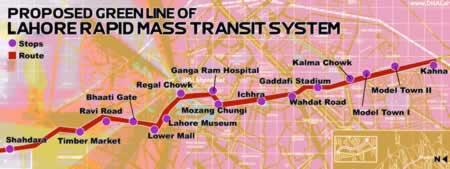
The Photo above shows the Route Map of LRMT Phase I – Green Line
The LRMT is a Two-phase, 97 kilometes long project. A Hong Kong based company called MVA Asia Consultancy was hired the government of Punjab as consultants to prepare the project feasibility. The study of MVA Asia Consultancy completed 5% of project design and proposed four Rail lines in the city to share the traffic burden. The proposed capacity of LRMT is going to be able to move 35000 passengers per hour in the city. Funding for the project will be provided by the Asian Development Bank (ADB).
PHASE I:
In Phase-I two tracks will be constructed. One will be a North-South route called the Green Line and other will be a East-West route called the Orange Line.
Green Line:
Green Line is going to cost US $2.4 billion to construct.
The Green Line would extend from Shahdara to Hamza Town via Ravi Road, Lower Mall, Mall Road, Fatima Jinnah Road, Qartaba Chowk and Ferozepur Road areas.
The Photo above shows the Route Map of LRMT Phase I – Green Line
The length of Green Line is going to be 27 km. 11.6 km long Green Line route would be underground, while 15.4 km long would be overhead.
There will be 12 underground and 10 overhead stations built on the Green Line route.
![]()
The completion dates of ‘Green Line’ is in 2011. Initially the project was supposed to finish in 2012 but due to Cricket World Cup od 2012 wher Lahore will be hosting few matches, the Green Line completion date has been pulled in to 2011. Initial estimates are that 227,000 people annually would benefit from the Green line.
In March 2007, Punjab Government invited Dr E. Sreedharan who is the managing director of successfully operating Delhi Metro Rail. After studying the project details Dr Sreedharan has declared Green Line Project as a viable one. He has inspected the first priority line’s route from Shahdara to Hamza Town. In his view, the implementation of the Green Line project (Phase I) would face no major technical difficulty because the soil condition en route was good and roads were wide, having room for underground construction without creating any serious inconvenience to the city.
Orange Line:
Orange Line is going to cost US $1.9 billion.
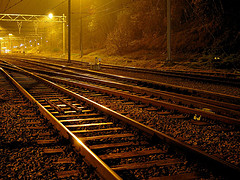 Its route would extend from Pakistan Mint to Sabzazar via Shahnur, Awan Town, Hinjarwal, Niaz Beg, Canal View, Wahdat Road, Ali Town, Salahuddin Road, Bund Road, Islam Park, Dera Gujjran Depot, Mahmood Booti, Salamatpura, Samanabad, Gulshan Ravi, Chauburji, Lake Road, Lakshami Chowk, Railway Station, Sultanpura, UET, Baghbanpura and Shalimar Garden areas.
Its route would extend from Pakistan Mint to Sabzazar via Shahnur, Awan Town, Hinjarwal, Niaz Beg, Canal View, Wahdat Road, Ali Town, Salahuddin Road, Bund Road, Islam Park, Dera Gujjran Depot, Mahmood Booti, Salamatpura, Samanabad, Gulshan Ravi, Chauburji, Lake Road, Lakshami Chowk, Railway Station, Sultanpura, UET, Baghbanpura and Shalimar Garden areas.
The length of Orange Line would also be 27-km out of which, 6.9 km long tracks would be underground, while 20.2 km-long would be overhead upon which six underground and 20 overhead stations would be established.
The central interchange station of Green and Orange lines would also be established besides linking these lines at Ring Road, railway station, airport, and Sports City.
The completion dates of ‘Orange Line’ is in 2015. Initial estimates are that 245,000 people annually would benefit from the Orange Train.
PHASE II:
The completion year for phase II is 2020.
In Phase-II, two more tracks will be laid out. These routes will be called Blue Line and Purple Line.
Blue Line:
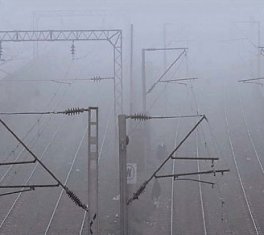 The route length of blue line is going to be 24 km. The ‘Blue Line’ will start from Chauburji and end at College Road, sources said, adding that from Chauburji the line would pass through Mozang Chungi, Shadman Chowk, Jail Road, Mian Boulevard Gulberg, Mian Boulevard Garden Town, Faisal Town and end at College Road.
The route length of blue line is going to be 24 km. The ‘Blue Line’ will start from Chauburji and end at College Road, sources said, adding that from Chauburji the line would pass through Mozang Chungi, Shadman Chowk, Jail Road, Mian Boulevard Gulberg, Mian Boulevard Garden Town, Faisal Town and end at College Road.
Purple Line:
The route length of Purple line is going to be 19 km. Purple line would start from Bhaati Chowk and end at Allama Iqbal International Airport. The line would pass through Bhaati Chowk, Brandreth Road, Railway Station, Allama Iqbal Road, Dharampura, Ghazi Road and end at Allama Iqbal International Airport
The Train Capacity:
One unit of air-conditioned train will have the seating capacity of 500 passengers.
Stations:
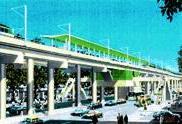
Environmental Concerns?
Just like with every Mega project, voices of dissent have started appearing for the project where people have shown concern for environment and noise levels of elevated trains. Dawn‘s editorial on Jult 12, 2007 covers these voices very concisely and I’ll quite the editorial here:
The first two lines will cost $3.3 billion. In real terms, the cost of the project is yet to be worked out. Surely, notes of dissent are expected to start pouring in. The economists are going to question the heavy debt the project will incur for the government and the citizens, while the opposition politicians are most definitely going to give their own colour to these lines and the sabza group may soon be out to enumerate the effects of this development on Lahore’s environment. Some of these points may be very valid and should elicit a thoughtful response from the government. There can be no moving ahead without this exercise. The sooner this essential exercise is carried out the better it would be for everyone.
Noise: I couldn’t find the details on expected noise levels around elevated portions of the track but noise is definitely going to travel far and away if sound barriers are not constructed around the tracks. More than normal decibels of noise are already witnessed around Pakistan Railway’s elevated track which runs from Lahore Station to Badami Bagh.
Previous Light Rail Studies or Projects:
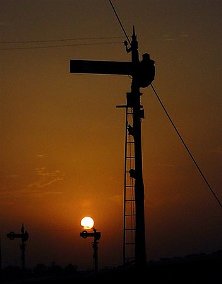 The current project is definitely not the first attempt to build a rail based mass transit for Lahore. In 1991 during Nawaz Sharif’s termas prime minister, the feasibility of a light rail transit system was determined by Japanese development organisation (JICA). It had proposed a 13 kilometre long system. The study was reviewed and updated as part of the World Bank funded “Lahore traffic and transport studies” in 1993.
The current project is definitely not the first attempt to build a rail based mass transit for Lahore. In 1991 during Nawaz Sharif’s termas prime minister, the feasibility of a light rail transit system was determined by Japanese development organisation (JICA). It had proposed a 13 kilometre long system. The study was reviewed and updated as part of the World Bank funded “Lahore traffic and transport studies” in 1993.
The system’s cost was estimated at about US $400 million, but with better network coverage. In 1995 Japan proposed financing the original scheme with grants and loans of about US $495 million, but the project could not be implemented due to many reasons.
Fares: Back in July 2007, it was reported in Daily Times that Passengers of the Lahore Rapid Mass Transit (LRMT) would be charged Rs 125 to Rs 140 to travel from one end to the other of the 27 kilometre-long Green Line.
“Sources associated with the project told Daily Times on Thursday that this (Rs 125-Rs 140) one-side fare had been calculated after taking into account the rendered $2.5 billion cost of the project, which is expected to be completed by 2011. Sources said that to pay back the loan likely to be incurred on the LRMT project, the government would have to charge high fares from the passengers. Currently, the public transport fare from Kahna to Shahdara is between Rs 20 to 25. By 2011, it would rise between Rs 25 and Rs 30. They said that to charge a passenger of the LRMT Rs 30 for a one-side visit, the government would have to give a subsidy of at least Rs 100 per person, which was not possible for the government.
While Rs 140 one way fare indeed looks ridiculous right now, passengers may end up paying much more than road transport. The benefiit however will be ease of travel, no traffic jams and hopefully a strict adherence to time table.
Hope: Many years ago I took a course in Engineering Economics. I still remember one sentence from my text book. It read as:
“All mega projects should be built as soon as possible after their design is done and funding is secured otherwise opposition to the project grows on POLITICAL basis.”
When we look around the mega projects of Pakistan, it appears so true. If big projecs are not started quickly they never will because somebody will always find a reason to do politics on the issue. In the end we sincerely hope the project sees the light of the day and does not end like the one in works for Karachi (called KMTP/KCR) for the past 33 years. Lets all hope for the best and we will continue to add updates on this project in the comments section below.
References
(1) Metroblogging Lahore
(2) Dawn Editorial of July 12, 2007 here.
(3) The News, February 26, 2006 here.
(4) MVA Consultancy
(5) Business Recorder Edition of June 10, 2007
(6) The Daily Times Edition of March 14, 2006
(7) ZeeNews edition of March 5, 2007
(8) Lahore Signs Light Rail MoU: September 1, 2002.
(9) Daily Times Edition of July 7, 2007
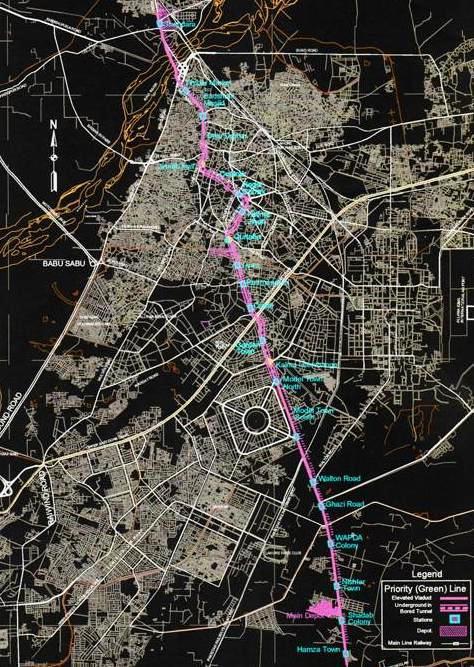




















































Dear Awais
Anyu further updates, as I believe that this project is abondoned after reading about this news. Awful indeed
I think most people will agree that scams for Pakistanis are like snow for Eskimos. Hardly shocking any more, the willing suspension of disbelief having gone the full round, anything and everything is possible, is acceptable and is believable. In fact such is the nationwide cynicism that the more bizarre the scam, the more believable it becomes. Stories about LPG quotas for all the top stakeholders who are holding on to the stakes for dear life are rampant. Everyone who is anyone seems to have tons of LPG ‘allocated’ to them. It is money for jam because no hard work is required, no daily grind here. Quotas in, LPG out, money in. Every day, hundreds of thousands of rupees are rolling into private coffers, no one daring to question the transparency of the deals that net millions to those who already have billions.
So this startling email — even by Pakistan’s jaded standards, popped up on my screen the other day. The subject? A Rs600 million corruption scam in the Study Report of the Lahore Mass Transit Train Project. The period? Just a few months between April and September this year. The sender of the email swears on all that is holy that every word, every amount of money siphoned off in this scam, is true and offers his email address for any verification. So those thinking that this is another irresponsible rumour of which variety this country has plenty might have to re-think. Is it a score-settling game? I doubt it.
The Punjab government has launched a Rs200 billion project for the transportation of millions of intercity commuters in Lahore. For the preparation of the study report, a Hong Kong-based consultancy firm was hired. In the preparation of this report, Rs600 million has changed hands in the form of bribes and kickbacks. Why the firm needs to buy at this stage the acquiescence of the lower staff, acting on their own or representing other powerful masters, remains a mystery. This report which has a vital bearing on the safety standards of the proposed system seems to be of critical importance to the foreign firm which instead of doing its work is apparently spending all its time and resources, greasing many outstretched palms.
The alleged main players are some officers and a clerk of the Punjab Transport Department and the AG’s office, but two main characters who emerge are a section officer and a clerk in BPS-10. Not only are both named, but their NIC numbers are also provided. The clerk fronts for the section officer who fronts for the others. Among other things the talented clerk has in a matter of six months procured seven vehicles in his brother, wife and friend’s names. The vehicles complete with registration numbers and names registered to, include two Honda Civics, a Toyota Corolla GLI, a Santro, a Cuore, a Toyota Camry (I want that sexy Camry) and an unregistered Prado. The gentleman providing these gory details admits that there are still some details missing. The value of these cars is known to all.
He goes on to list the money deposited in the NIB Bank in Lahore complete with account numbers. Here the clerk’s lady wife has a number of hefty deposits to her good name. These deposits made between May and September 2007 range from Rs2.15 crores, Rs2 crores again two weeks later, another two crores a day later, Rs20 lacs in July, another Rs2.5 crores in September, followed by Rs60 lacs a week later and another similar sum another week later. It all adds up to many crores, many lacs and too many thousands which I can’t write in figures my French being what it is.
The head clerk who must be a very busy man has another set of accounts at Habib Bank (mera be to hai) where he and his lady wife plonked Rs75 lacs in September. This comes with details of the account number, beneficiary etc. A similar sum of money is placed by the enterprising clerk’s lucky brother on the same dates. That is Rs 75 lacs again in case you are losing the thread of the narrative. There are reportedly more accounts or more sums of money deposited here of which details are not known. Why we cannot make this head clerk Pakistan’s finance minister I’ll never know, but such talent should hardly go unnoticed — can’t really say unrewarded.
Having done with the cars and the bank accounts, next on the menu is the dessert. This comes in the shape of a rich cheesecake and is just as appetising as cheesecakes are reputed to be. The mysterious boss appears at last but the lead roles are still shared by the head clerk and his lady wife against which fair lady, Lady Macbeth has begun to look more and more like Mother Teresa. However, dessert awaits. In Iqbal Town, Lahore, the boss has a plot — a modest affair worth about Rs1.5 crores only. The adjoining plot — anyone remember ‘birds of a feather flock together?’ — is with Lady Macbeth valued the same. The party then moves to Gulshan-e-Ravi where three plots are picked up valued at about Rs3.25 crores in all. A house in Old Anarkali for Rs70 lacs and another modest dwelling on Food Street, valued at Rs35 lacs are also with the dear lady. In what is obviously a ‘loot sale’, Lady Macbeth then picks up two villas in Gulshan-e-Ravi for Rs2.25 crores, a flat on Maclagan Road for Rs15 lacs and a house in Shalimar Colony in his/her brother brother-in-law’s name for Rs20 lacs, a shop in Old Anarkali for Rs15 lacs and another for Rs70 lacs. Another shop in Mozang for Rs15 lacs, two small hotels on Food Street for Rs1.2 crores and Rs20 lacs and a jewellery shop in Anarkali for Rs70 lacs completes the bonanza. Total value of these properties? Rs14 crores, 85 lacs. How much does it all add up to? God knows how much, since I have lost count.
As for after dinner chocolates, the enterprising group has picked up a wholesale gold business in Old Anarkali (I guess that’s where all the action is) for a paltry Rs1.5 crores plus another two business units for Rs15 lacs each, all these goodies registered in the names of two brothers and a son. Total value of this initiative? Rs1.5 crores, 30 lacs. So, those of you still struggling with your lacs and crores, the entire package is about Rs18 crores give or take a crore this way or that. I now understand what Shaukat Aziz kept calling the ‘trickle down’ effect and dud that I was, never quite understood that brilliant man. But to our sleuth some marks for detailed probing are perhaps due because he had attached two approved bills pertaining to Sep-Oct complete with invoice numbers, details of the invoices and amounts paid into the company’s accounts in Citibank.
The question is, whether this is true or not? If false, why go into so many details? Is it someone done out of this deal, now spilling the beans or is it someone who is sincere and horrified at this blatant corruption? Who knows? Why is this foreign company having to shell out so much money at a study phase level? How can they afford so much payoffs? Are they incompetent? Is this project another Jinnah Flyover that collapsed within a month of its opening? No wonder they called it a flyover! And of course our dear ‘jawans’ who built this engineering marvel have not been singled out and punished at all. Not that anyone was expecting it. We are all used to scams and every deal in Pakistan is shady. The purchase of PIA’s 777 aircraft routed through a company, Taxila Inc, registered (but of course) in Cayman Islands with a grand paid-up capital of $ 250 just 11 days before the banks pushed the loans through has the same smell as fish left out in the sun, but who is probing it? The lurid details of Lahore’s Mass Transit payoffs need to be investigated. But then, who is going to do it?
Shame for the previous Government and same fate of mega projects in pakistan.
I guess the fares are hilarious!! Or maybe something is wrong somewhere!
Currently we pay up to INR 24 for Delhi Metro end to end travel and the company is still making profits. Although, probably end to end fares will go up by 2010 when total route length shall be about 185 kms.
I had read in a newspaper in my city a few months back, that they will keep fares along New Delhi – IGI Airport line hilariously high to discourage travellers (for security reasons). And they suggested the fares may be as high as INR 100. Now, either your system is going to be TOO expensive, or somewhere the figures are incorrect.
More news on this;
http://jang.com.pk/jang/sep2007-daily/26-09-2007/u p37.gif
Apparently, the $3 billion project will start soon after Eid.
Some minor clarifications/corrections
Clarification:
Union govt = central/federal govt.
Correction:
When I referred to the other cities, I said that part of the funds are coming from lending organizations like the JBIC/ADB etc. and the rest by the state government. Actually I meant that the rest is being shared by the central (federal) and state governments in equal proportion.
Aqil:
DMRC is earning revenues through commercial development. It has tendered out advertising rights inside trains, on the platform and other station venues and also by awarding concessions for running restaurants and coffee/tea shops. Another source of revenue is from mobile companies. Even the underground sections of the metro have a mobile signal and this is achieved by installing repeaters on the metro route that the mobile companies pay DMRC for. Besides this, DMRC is earning revenues through property development. They are constructing an IT park in the area adjacent to one station and a residential development above a coach depot.
As to funding, 60% of the project cost is borne by the Japanese Bank of International Cooperation (JBIC). It is a subsidized loan, with a 10 year moratorium on payments. 15% of the cost is borne by the union Govt. (mostly as cash) and 15% by the Govt. of Delhi (partly as cash and partly as land transferred to DMRC for building its facilities). The rest is generated by DMRC through property development (and is in fact an indirect subsidy from the Govt. of Delhi, since it has provided high value land to DMRC for use for property development).
Now there are metros under construction or being planned in various cities of India – Bangalore, Hyderabad, Chennai, Pune, Kochi, Ahmedabad and Kolkata – and a similar pattern of financing is being used/planned there as well. Typically a concessional loan from JBIC/World Bank/Asian Development Bank or a similar agency covering 50-60% of the cost and the rest being shared by state Governments. Mumbai is using a different model, where the state and central governments share a viability gap financing to a private developer, who invests the rest of the funds. One line has already been contracted out to Anil Ambani’s company by this route, and more lines are under the process of being tendered. This works in Mumbai since it is a city with high public transit usage – making the metro profitable for private developers (with some viability gap financing by the Government). Even in Mumbai, the fares are regulated though – Line 1 of the metro will have a typical fare of Rs. 10 for a 10 km distance.
I hope this answers your questions.